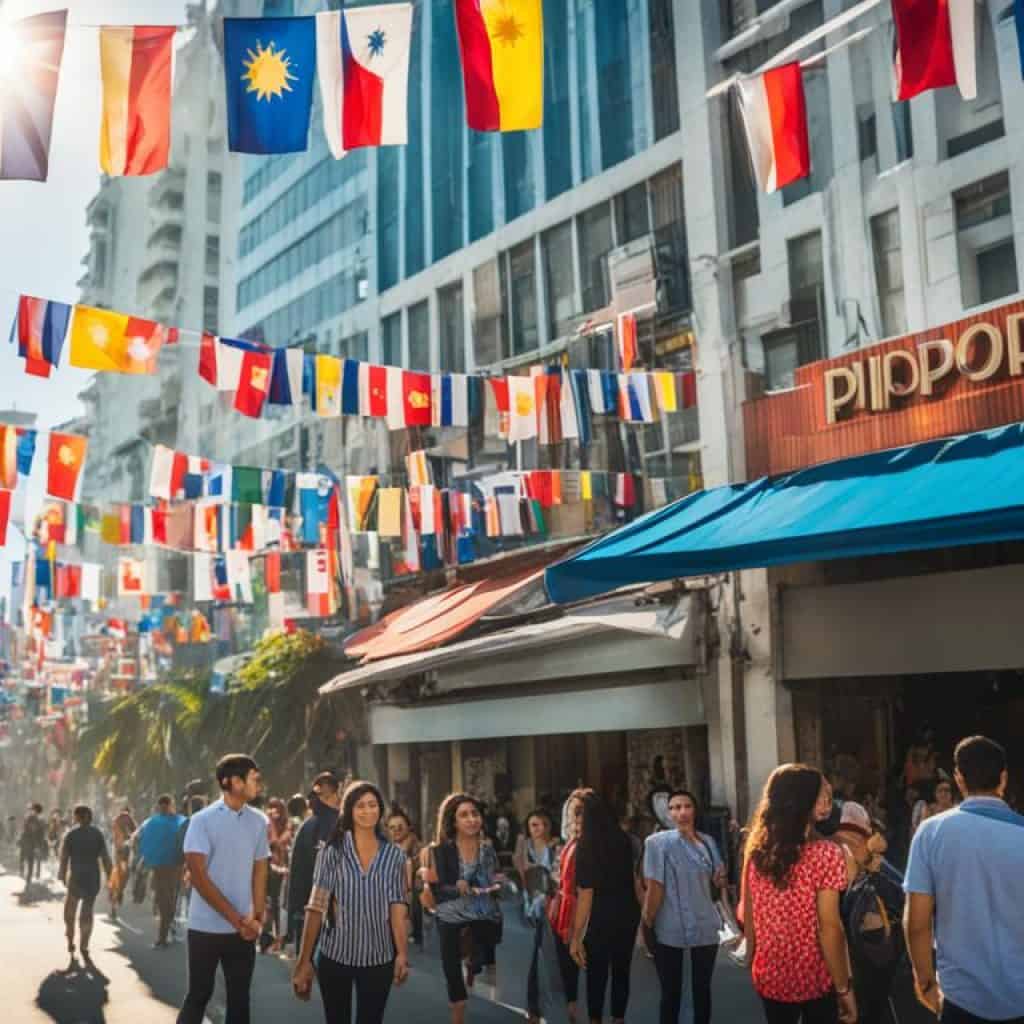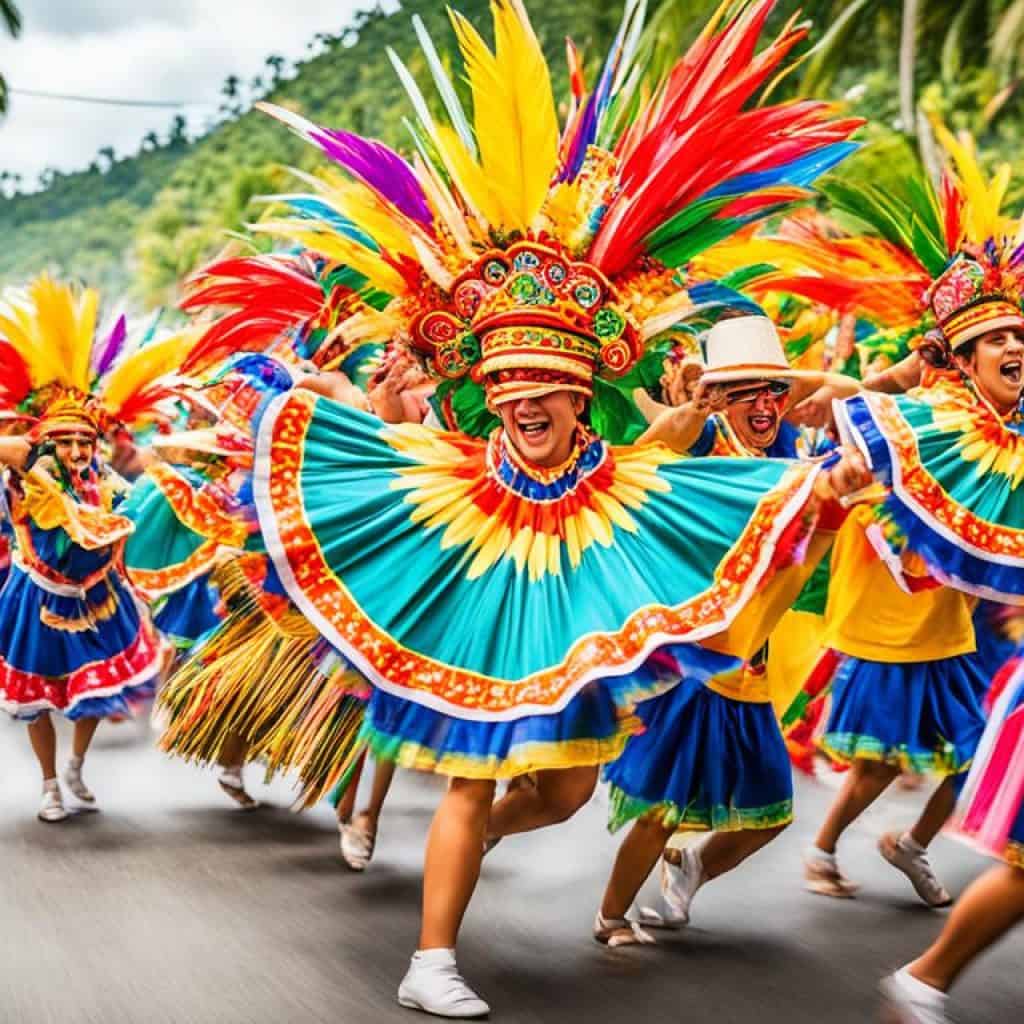Have you ever wondered what it’s like to live as a foreigner in the Philippines? Is it a country that embraces diversity and offers opportunities for growth? Or are there challenges that come with being an outsider in this tropical paradise?
The Philippines is a nation with a rich history of migration and diverse cultural influences. From the Austronesian migrations to Spanish colonization and American influence, the country has been shaped by a myriad of foreign influences. But what is life like for foreigners in the Philippines today? How do they navigate the complexities of immigration, find employment opportunities, and immerse themselves in the vibrant local culture?
In this article, we will delve into the world of foreigners in the Philippines, exploring their experiences, challenges, and the unique opportunities they encounter. Whether you’re considering a move to the Philippines or simply curious about the lives of those who call it home, join us as we uncover the fascinating stories and insights of foreigners navigating their way through this cultural melting pot.
Key Takeaways:
- The Philippines is a country with a rich history of migration and diverse cultural influences.
- Foreigners in the Philippines face unique challenges and opportunities in terms of immigration and employment.
- The vibrant expat communities and diverse cultural experiences make living in the Philippines a truly enriching experience.
- The country’s stunning natural beauty and warm climate make it a popular destination for travel and exploration.
- From education to healthcare, foreigners in the Philippines have access to a range of services and resources.
The Peopling of the Philippines: Austronesian Migration
The peopling of the Philippines can be traced back to the migrations of the Austronesian peoples. These migrations have played a crucial role in shaping the cultural and genetic landscape of the country. Two main theories exist regarding the origins of these migrations – the “Out of Sundaland” models and the “Out of Taiwan” model.
The Out of Sundaland models propose that the Austronesian peoples originated from the area known as Sundaland, which was a large landmass that included present-day Indonesia and parts of Southeast Asia. They believe that these early pioneers gradually made their way to the Philippines, bringing with them their language, traditions, and way of life.
On the other hand, the Out of Taiwan model suggests that the Austronesian peoples originated from Taiwan. According to this theory, waves of migrations occurred, with groups of Austronesian-speaking people gradually making their way southward, eventually settling in the Philippine archipelago. This theory is supported by linguistic, genetic, archaeological, and cultural evidence, making it widely accepted among scholars and experts.
These Austronesian migrations not only resulted in the establishment of diverse communities across the Philippine islands but also led to the blending of cultures and the formation of a unique Filipino identity. The various ethnic groups that now exist in the Philippines can trace their roots back to these ancient migrations.
Historical Immigration Waves: Spanish and American Periods
The Philippines has a rich history of migration, with waves of foreigners shaping the country’s cultural landscape. Two periods that significantly influenced the demographics of the Philippines are the Spanish colonization and the American colonial era.
Spanish colonization brought people from Spain and Mexico to the Philippine archipelago. This period, which lasted for over 300 years, resulted in the emergence of Filipino mestizos with mixed Austronesian and Hispanic heritage. The Spanish introduced new customs, traditions, and the Catholic religion, which still play a significant role in Filipino culture today.
The American colonial era, which followed the Spanish colonization, saw the arrival of Americans in the Philippines. The 1898 Treaty of Paris between Spain and the United States transferred control of the Philippines to the latter. During this time, more than 800,000 Americans were born in the Philippines, contributing to the diverse population. The American influence is evident in various aspects, including language, education, and governance.
Spanish Colonization: A Mestizo Community Emerges
Spanish colonization began with the arrival of Ferdinand Magellan in 1521, marking the start of European influence in the Philippines. The Spanish brought over settlers, soldiers, and missionaries, who intermarried with the native population and created a mestizo community. The mestizos played a crucial role in the development of Filipino society and identity, bridging the gap between Austronesian and Hispanic cultures.
“The Spanish colonization of the Philippines laid the foundation for the unique blend of cultures and traditions that define the country today. It brought about cross-cultural exchanges that shaped the identity of the Filipino people.” – Dr. Maria Isabel Caneda, Philippine Historian
The Spanish also introduced changes in the political and social structure of the Philippines. They established the encomienda system, which granted land and labor to Spanish colonizers, and introduced Christianity, making the Philippines the largest Catholic nation in Southeast Asia.
American Colonial Era: Shaping Modern Philippines
The American colonial era started after the United States acquired the Philippines from Spain in 1898. The Philippines became a strategic outpost for American interests in the Pacific region. The American government implemented significant changes, including the introduction of a public education system, English as the medium of instruction, and modern infrastructure development.
The American influence extended beyond governance and education. It also left a lasting impact on the cultural landscape, with elements of American fashion, music, and entertainment becoming popular.
Despite the Philippines gaining independence from the United States in 1946, the American presence remains evident. As of 2020, there are approximately 6,306 American citizens living in the Philippines, contributing to the multicultural fabric of the country.
Spanish and American Immigration Statistics
| Immigration Period | Origin | Number of Immigrants |
|---|---|---|
| Spanish Colonial Period | Spain | Approximately 30,000 settlers |
| Mexico | Unknown | |
| American Colonial Era | United States | Over 800,000 Americans born in the Philippines |
| Total number of Americans residing in the Philippines (2020) | 6,306 | |
The immigration statistics highlight the substantial impact of Spanish colonization and the American colonial era on the composition of the Philippine population.
The Spanish and American periods significantly shaped the history, culture, and demographics of the Philippines. These influences continue to be celebrated and embraced by the Filipino people, making the country a truly unique tapestry of diverse cultures and traditions.
Current Foreign Citizenship in the Philippines
The Philippines is home to a diverse population of foreign citizens, adding to the vibrant and multicultural atmosphere of the country. Let’s take a look at the demographics and the top nationalities of foreign citizens in the Philippines.
Demographics of Foreign Citizens in the Philippines
Foreign citizens from various countries have chosen to make the Philippines their home. The top three nationalities among foreign citizens in the Philippines are:
- Chinese citizens
- Indian citizens
- American citizens
With a significant number of Chinese, Indian, and American citizens, the Philippines represents a melting pot of cultures and backgrounds.
Top Nationalities and Their Contributions
The diverse population of foreign citizens in the Philippines has made significant contributions to the country’s social, cultural, and economic landscapes. Here is a breakdown of the top nationalities and their notable contributions:
| Nationality | Population in the Philippines | Contributions |
|---|---|---|
| Chinese | Highest population | Significant investments, trade partnerships, and cultural exchange |
| Indian | Second highest population | Entrepreneurship, technology, and professional services |
| American | Third highest population | Educational and professional exchanges, diplomatic relations, and cultural engagement |

“The presence of foreign citizens in the Philippines enriches our society and fosters international collaboration. Their contributions across various sectors play a vital role in our country’s development and growth.”
As the Philippines continues to be a welcoming destination for foreigners, the cultural diversity and global connections bring about a vibrant synergy that benefits both the local and expatriate communities.
Laws and Visas for Foreigners in the Philippines
The Philippines has established a comprehensive system of laws and regulations to govern immigration and visa policies for foreigners. This ensures that individuals visiting or residing in the Philippines have the necessary permissions and legal status in the country.
Types of Visas
Foreigners entering the Philippines can apply for different types of visas based on their purpose of visit or length of stay. The two main categories of visas are:
- Non-immigrant Visas: These visas are designed for temporary visits to the Philippines, such as tourism, business, or study. They allow foreigners to stay in the country for a limited period and do not grant permanent residency.
- Immigrant Visas: Immigrant visas are intended for individuals who wish to permanently reside in the Philippines. These visas provide a pathway to obtaining permanent residency and, eventually, citizenship.
Aside from these main categories, the Philippines also offers special visas for specific groups of people, including retirees, investors, and entrepreneurs, among others.
Bureau of Immigration
The enforcement and administration of immigration laws in the Philippines are overseen by the Bureau of Immigration. This government agency is responsible for managing the admission, registration, and deportation of foreign nationals.
The Bureau of Immigration ensures that all individuals entering and residing in the Philippines comply with the country’s immigration regulations. They handle visa applications, conduct screening processes, and maintain records of foreign nationals within the country.
Adhering to Philippine Immigration Laws
“It is essential for foreign visitors and residents in the Philippines to adhere to the country’s immigration laws. This ensures a smooth and legal stay in the country, protecting the rights and privileges of both foreigners and the local population.”
The Philippines welcomes foreigners who comply with immigration laws and contribute positively to the country’s cultural and economic growth. It is crucial for individuals to be aware of the specific requirements, documents, and processes involved in obtaining the appropriate visa for their purpose of visit or stay.
| Visa Type | Requirements |
|---|---|
| Non-immigrant Visa | – Valid passport – Completed visa application form – Supporting documents for the specific purpose of visit (e.g., invitation letter, hotel reservations, return ticket) – Proof of financial capacity |
| Immigrant Visa | – Valid passport – Completed visa application form – Supporting documents for permanent residency (e.g., marriage certificate, proof of investment, proof of employment) – Medical examination results – Police clearance – Proof of financial capacity |
Next, we’ll explore the status of refugees in the Philippines, including the country’s history of accepting individuals fleeing from conflict, persecution, and natural disasters.
Refugees in the Philippines
The Philippines has a long-standing tradition of providing refuge to those fleeing from conflict, persecution, and natural disasters. Over the years, the country has welcomed refugees from various parts of the world. This acceptance of refugees has not only demonstrated the compassion and generosity of the Filipino people but has also contributed to the multicultural fabric of the Philippines.
Throughout history, the Philippines has opened its doors to those seeking safety and a new beginning. Some notable examples of refugees who found sanctuary in the Philippines include:
- Refugees from the Russian Empire during the early 20th century
- Jewish refugees escaping Nazi Germany during World War II
- Spanish Republicans seeking asylum after the Spanish Civil War
- Chinese refugees fleeing the Chinese Civil War
- Vietnamese refugees during the Vietnam War
- Iranian refugees escaping political turmoil and persecution
- East Timorese refugees fleeing violence during their struggle for independence
These are just a few examples of the diverse range of refugees who have found safety and a new home in the Philippines. The country’s commitment to refugee acceptance is rooted in its belief in providing humanitarian aid and support to those in need.
The acceptance of refugees in the Philippines not only offers a lifeline to those fleeing from dire circumstances but also allows them the opportunity to rebuild their lives and contribute to the society. Sometimes, refugees bring with them unique skills, knowledge, and cultural experiences that enrich the local communities.
“The Philippines has long been known as a haven for those seeking refuge. The compassion and warmth of the Filipino people create an environment where refugees can find solace and hope. It is a testament to the country’s commitment to humanitarianism.” – Refugee Advocate
The Philippines continues to prioritize refugee acceptance, working closely with international organizations and neighboring countries to ensure the safety and well-being of those seeking asylum. These collaborative efforts help provide the necessary infrastructure and support systems to accommodate refugees and facilitate their integration into the local communities.
Refugee Acceptance in Philippines - Statistics
| Year | Number of Refugees Accepted |
|---|---|
| 2015 | 3,430 |
| 2016 | 4,112 |
| 2017 | 4,759 |
| 2018 | 5,621 |
| 2019 | 6,218 |
The table above provides an overview of the number of refugees accepted in the Philippines in recent years. It is important to note that these statistics represent only the officially registered refugees and do not take into account individuals who may have found refuge through unofficial means.
These numbers highlight the Philippines’ ongoing commitment to providing a safe haven for those in need, reinforcing its reputation as a welcoming and compassionate nation.
Transportation and Mobility for Foreigners in the Philippines
Getting around in the Philippines can be an adventure in itself, especially for foreigners. With a variety of transportation options available, it’s important to know the best ways to navigate the bustling streets and vibrant cities of this beautiful country.
Driving in the Philippines
While public transport is a popular choice, many foreigners opt to drive in the Philippines to have more flexibility and independence. However, it’s essential to mention that driving in the country can be quite chaotic and different from what you may be used to. Drivers often disregard traffic rules, and navigating through the busy streets may require extra vigilance.
If you decide to drive, be prepared for a unique experience on the roads. It’s advisable to rent a car from a recognized international rental company and ensure you have valid international or Philippine driving license. Remember to familiarize yourself with local traffic laws and take extra precautions while driving.
Taxis and Ride-hailing Apps
Taxis are widely available in the Philippines and can be a convenient mode of transportation, especially for short distances or when you prefer not to drive. Most taxi drivers can understand and communicate in basic English, making it easier for foreigners to get around.
Ride-hailing apps such as Grab are also popular and reliable options for transportation. These apps allow you to book a ride with a few taps on your smartphone, providing convenience and peace of mind.
Public Transportation
Trains are a good option for traveling within and between major cities. Metro Manila, for example, has the Light Rail Transit (LRT) and Metro Rail Transit (MRT) systems that can take you to various destinations efficiently.
Jeepneys, an iconic mode of transportation in the Philippines, are colorful and open-air vehicles that follow set routes. They are a great way to experience the local culture and interact with fellow passengers.
For island-hopping and coastal destinations, boats and ferries are popular choices. They offer picturesque views and give you the opportunity to explore the stunning islands and beaches that the Philippines is known for.
Remember to plan your journey and consider the time of day and traffic conditions. Public transportation can be crowded, especially during peak hours, so allow extra time for your travels.
Expat Communities and Services in the Philippines
Living as an expat in the Philippines opens up a world of opportunities. The country boasts vibrant expat communities, especially in bustling cities like Manila and Cebu. These communities provide a supportive network and offer a range of services and resources tailored to the needs of expats.
Expats in the Philippines can connect with like-minded individuals through social clubs and organizations. These groups organize events, outings, and gatherings, providing a platform for expats to meet new friends and build lasting connections. Joining a social club not only helps expats feel more at home but also introduces them to the local culture and customs.
When it comes to education, expat families can choose from international schools that follow recognized curricula such as the International Baccalaureate or American system. These schools provide a high-quality education in English, ensuring seamless academic transitions for expat children.
Healthcare services in the Philippines cater to the needs of residents, including expats. A wide range of private hospitals and clinics offer excellent medical facilities and highly skilled healthcare professionals. Expats can also find expat-oriented healthcare centers that understand their specific medical requirements.
“Living in the Philippines as an expat provides a unique opportunity to access a range of specialized services and resources tailored to your needs and preferences.”
Expats can also take advantage of various services and businesses specifically designed for their convenience. From legal assistance and relocation services to language schools and employment agencies, expats can find support in every aspect of their life in the Philippines. These expat-oriented businesses understand the challenges and requirements of living in a new country and strive to make the transition smoother for expats.
For information and support, expats can turn to online forums and expat websites. These virtual communities offer a wealth of knowledge and insight, providing expats with practical advice, recommendations, and a platform to connect with others in a similar situation. Expats can ask questions, share experiences, and find relevant information to navigate their life in the Philippines.
With the presence of expat communities and dedicated services, living as an expat in the Philippines becomes a truly enriching experience. Expats can embrace the local culture, build relationships, and access the resources they need to create a fulfilling life in this beautiful tropical paradise.
Cultural Experiences for Foreigners in the Philippines
The Philippines offers a rich cultural experience for foreigners, allowing them to immerse themselves in the vibrant traditions and lifestyle of the country. From colorful festivals to delectable culinary delights, there is something to captivate every visitor.
One of the most exciting cultural events in the Philippines is the Sinulog Festival, held annually in Cebu City. This grand celebration showcases street parties, processions, and lively performances that honor the country’s religious and cultural heritage. Visitors can join in the revelry, savoring the rhythmic beats, and witnessing the intricate dance routines.

Exploring Filipino cuisine is another delightful way to experience the culture. A must-try dish is adobo, a savory and tangy meat stew made with soy sauce, vinegar, garlic, and spices. This iconic Filipino favorite is a staple in local households and embodies the fusion of Spanish and indigenous flavors.
For a sweet treat, indulge in halo-halo, a refreshing dessert made with a colorful medley of ingredients such as shaved ice, sweetened fruits, jellies, beans, and leche flan. This delightful concoction is a perfect reflection of the Philippines’ tropical lifestyle.
Must-Visit Cultural Destinations
When exploring the Philippines, there are several cultural destinations that should not be missed:
- The historic walled city of Intramuros in Manila, which takes visitors back in time with its Spanish colonial architecture and preserved landmarks.
- The scenic province of Bohol, known for its iconic Chocolate Hills and tarsier sanctuaries, offering a glimpse into the country’s diverse wildlife.
- The colorful island of Panay, home to the vibrant Ati-Atihan Festival in Kalibo, where locals and tourists alike paint their faces and dance in the streets to honor Santo Niño.
These destinations provide a deeper understanding of the rich cultural tapestry that defines the Philippines.
| Cultural Experience | Description |
|---|---|
| Sinulog Festival | A lively and colorful celebration in Cebu City featuring street parties, processions, and dance performances |
| Adobo | A savory meat stew made with soy sauce, vinegar, garlic, and spices, representing the fusion of Spanish and indigenous flavors |
| Halo-Halo | A refreshing dessert made with shaved ice, sweetened fruits, jellies, beans, and leche flan, embodying the tropical lifestyle of the Philippines |
Working and Employment Opportunities for Foreigners in the Philippines
Foreigners in the Philippines have access to a wide range of employment opportunities in various sectors. The country’s growing economy offers job prospects in industries such as manufacturing, services, and tourism. With its strategic location and vibrant business environment, the Philippines has become an attractive destination for foreign investors and multinational companies.
Let’s take a closer look at the job market for foreigners in the Philippines:
- Manufacturing Sector: The manufacturing industry in the Philippines is thriving, with a focus on electronics, garments, food processing, and automotive products. Foreigners with technical skills and experience in engineering, production, and quality control can find rewarding employment opportunities in this sector.
- Services Sector: The services sector is a significant contributor to the Philippine economy, particularly in areas such as business process outsourcing (BPO), information technology, finance, and customer service. Foreigners with proficiency in English and expertise in these fields are highly sought after by local and international companies.
- Tourism Sector: The Philippines is known for its beautiful beaches, stunning landscapes, and unique cultural heritage. As a result, the tourism industry offers employment opportunities for foreigners in areas such as hospitality, tour guiding, and event management. Fluency in English and knowledge of other languages can be advantageous in customer-facing roles.
According to the Philippine Statistics Authority, the top nationalities of registered aliens holding work permits in the Philippines are Chinese, Koreans, and Americans. Many foreigners have secured administrative, executive, and managerial positions, contributing to the country’s economic growth and development.
Work Permit Requirements
Foreigners who wish to work in the Philippines are required to secure appropriate work permits and visas. The Bureau of Immigration is responsible for the issuance and regulation of these permits. The specific requirements and procedures may vary depending on the type of employment and the duration of stay.
“The Philippines offers a wide range of employment opportunities for foreigners in various sectors, including manufacturing, services, and tourism. With its growing economy and attractive business environment, the country attracts individuals seeking professional growth and new experiences.”
The following table provides an overview of the top nationalities holding work permits in the Philippines:
| Nationality | Number of Work Permit Holders |
|---|---|
| Chinese | XX,XXX |
| Koreans | XX,XXX |
| Americans | XX,XXX |
As the table illustrates, Chinese, Koreans, and Americans are among the top nationalities holding work permits in the Philippines. However, the job market remains diverse, and opportunities exist for individuals of various nationalities and backgrounds.
Foreigners who wish to work in the Philippines should research and comply with the necessary legal requirements, such as obtaining the appropriate work permits and visas. It is also advisable to network and engage with local professionals and expat communities to explore employment opportunities and gain valuable insights about the job market.
The image above depicts professionals working in the Philippines, representing the diverse and dynamic work environment that foreigners can experience in the country.
Education and Healthcare for Foreigners in the Philippines
Foreigners in the Philippines have access to a wide range of educational and healthcare options, ensuring a well-rounded life in the country. Whether you are moving to the Philippines with your family or as an individual, you can find quality education and healthcare services to meet your needs.
Educational Opportunities
International schools and universities in the Philippines offer excellent educational services tailored to the needs of expat families. These institutions provide a variety of curricula, including internationally recognized programs such as the International Baccalaureate (IB) and Advanced Placement (AP) courses. The language of instruction is primarily English, making it easier for foreign students to adapt and excel in their studies.
International schools in the Philippines often have diverse student populations, allowing students to engage with peers from different cultural backgrounds. This enriches the learning experience and promotes cross-cultural understanding and friendship.
“The diversity and inclusive nature of international schools in the Philippines provide a nurturing environment for students to thrive academically and socially.” – Educational Consultant
Furthermore, the Philippines is also home to reputable universities that offer undergraduate and postgraduate programs across various disciplines. These universities maintain high standards of education, ensuring that students receive a quality education that aligns with international standards.
Healthcare Services
The healthcare system in the Philippines is comprehensive and caters to the needs of both locals and expatriates. The country has a mix of public and private hospitals and clinics, providing a wide range of medical services.
Public hospitals offer affordable healthcare services, making them accessible to a larger percentage of the population. Although public hospitals may have limited resources, they generally provide basic medical treatment and emergency services.
Private hospitals, on the other hand, offer a higher level of medical care and a wider range of specialties. These hospitals often have state-of-the-art facilities, advanced medical technology, and internationally trained healthcare professionals. Expatriates in the Philippines often choose private healthcare facilities for their specialized services and personalized care.
The availability of healthcare services extends beyond hospitals, with clinics, dental practices, and specialized medical centers offering comprehensive care for various medical needs. The Philippines has a reputation for its competent and caring healthcare professionals who prioritize patient well-being.
Educational and Healthcare Facilities for Foreigners
Foreigners in the Philippines can find educational and healthcare facilities tailored to their specific needs. As an expat, you can rely on the world-class education provided by international schools and universities. These institutions not only focus on academic excellence but also foster a global mindset and prepare students for further studies or international careers.
In terms of healthcare, whether you require routine check-ups, specialized treatments, or emergency medical care, you can find reliable services in both public and private healthcare facilities. The Philippines prioritizes the health and well-being of all residents, offering affordable and high-quality medical care.

| Educational Opportunities | Healthcare Services |
|---|---|
| International schools and universities | Public and private hospitals |
| Diverse student populations | Affordable and accessible healthcare |
| English as the language of instruction | Specialized medical treatments |
| Recognized curricula (IB, AP) | Competent healthcare professionals |
Travel and Exploration in the Philippines for Foreigners
The Philippines is a country renowned for its breathtaking natural beauty, offering a paradise for foreigners looking to explore and discover new adventures. With thousands of islands scattered across its archipelago, travelers are spoiled for choice with pristine beaches, majestic mountains, and diverse ecosystems waiting to be explored.
For those seeking popular tourist destinations, the Philippines offers iconic spots such as Boracay, Palawan, and Bohol. Boracay captivates visitors with its white sandy beaches and clear turquoise waters, perfect for swimming, sunbathing, and engaging in various water sports activities. Palawan, known as the “Last Frontier,” enchants with its stunning limestone cliffs, secluded coves, and vibrant marine life, making it a haven for snorkeling and diving enthusiasts. Bohol entices travelers with its striking Chocolate Hills, cute tarsiers, and beautiful coastal landscapes, providing endless opportunities for adventure and scenic exploration.
However, the true allure of the Philippines lies in its hidden gems that beckon intrepid travelers to venture off the beaten path. From the enchanting waterfalls of Siquijor to the surreal landscapes of Batanes, there are countless off-the-radar destinations waiting to be discovered. These lesser-known places offer a chance to immerse oneself in the unspoiled beauty of nature and experience a sense of tranquility away from the bustling tourist crowds.
One of the most remarkable aspects of traveling in the Philippines is the warm hospitality and friendly nature of the locals. Filipinos are known for their warm smiles, genuine kindness, and eagerness to assist tourists, creating a welcoming and inviting atmosphere for foreign travelers. Their hospitality extends beyond just offering directions or recommendations – it’s a genuine desire to make visitors feel at home and create lifelong memories.
“The Philippines is a country with so much to offer in terms of natural wonders. Whether you’re looking to relax on pristine shores, hike through lush mountains, or discover hidden waterfalls, the Philippines has it all. The warmth of the Filipino people adds an extra layer of magic to the experience, making it a truly unforgettable destination.”
Traveling and exploring the Philippines is a journey that allows foreigners to connect with nature, experience diverse cultures, and create lasting memories. The country’s tropical climate ensures a year-round opportunity for outdoor adventures and immersing oneself in the richness of the islands. With each trip to the Philippines, foreigners have the chance to unearth new adventures, encounter captivating landscapes, and gain a deeper appreciation for the beauty of this Southeast Asian gem.
Conclusion
Living in the Philippines as a foreigner offers an incredible and vibrant experience. Whether you are drawn to the rich cultural heritage, the breathtaking natural landscapes, or the warm and welcoming people, this tropical nation has something to offer everyone seeking a new adventure.
One of the most striking aspects of living in the Philippines is the diverse population. As a foreigner, you will have the opportunity to interact with people from different backgrounds and cultures, contributing to the vibrant and inclusive atmosphere. The presence of expat communities in major cities like Manila and Cebu further adds to the sense of belonging and support for foreigners.
Moreover, the Philippines provides a range of opportunities for work, education, and travel. With a growing economy, there are employment options in various sectors, and foreigners often hold important positions in administration, management, and entrepreneurship. The country’s education system offers international schools and universities, ensuring quality education in English. Additionally, the Philippines’ stunning natural beauty, from pristine beaches to majestic mountains, makes it a perfect destination for travel and exploration.
In conclusion, living in the Philippines as a foreigner allows you to immerse yourself in a unique and enriching experience. With its diverse population, welcoming communities, and abundant opportunities for work, education, and travel, the Philippines is a truly exceptional destination for foreigners seeking to create unforgettable and fulfilling experiences.
FAQ
What is the process for immigration to the Philippines?
Immigration to the Philippines involves migrating to the country to reside or become a citizen. The Bureau of Immigration is responsible for enforcing immigration laws and administering visas for temporary visits and permanent residency.
How diverse is the population of foreigners in the Philippines?
The population of foreign citizens in the Philippines is diverse, with the highest numbers coming from China, India, and the United States. This multicultural population contributes to the vibrant and diverse atmosphere in the country.
What types of visas are available for foreigners in the Philippines?
The Philippines offers different visa categories for foreigners, including non-immigrant visas for temporary visits and immigrant visas for those seeking permanent residency. There are also special visas for retirees, investors, and entrepreneurs.
Does the Philippines accept refugees?
Yes, the Philippines has a history of accepting refugees fleeing from conflict, persecution, and natural disasters. The country has provided refuge to people from various countries, including Russia, Germany, Spain, China, Vietnam, Iran, and East Timor.
What are the transportation options for foreigners in the Philippines?
Public transport in the Philippines can be crowded, so many foreigners choose to drive or use taxis. Driving in the Philippines can be chaotic, but taxis are widely available, and ride-hailing apps are also an option. Public transportation includes trains, buses, jeepneys, boats, ferries, and domestic flights.
Are there expat communities in the Philippines?
Yes, the Philippines has vibrant expat communities, especially in major cities like Manila and Cebu. These communities offer services and resources to support expats, including social clubs, schools, healthcare facilities, and expat-oriented businesses.
What cultural experiences can foreigners enjoy in the Philippines?
The Philippines offers a rich cultural experience for foreigners, with diverse traditions, festivals, culinary delights, and artistic expressions. From vibrant street parties to traditional cuisine, there are countless opportunities to immerse oneself in Filipino culture and lifestyle.
What employment opportunities are available for foreigners in the Philippines?
Foreigners in the Philippines have employment opportunities in various sectors, including manufacturing, services, and tourism. The top nationalities of registered aliens holding work permits are Chinese, Koreans, and Americans. Many foreigners hold administrative, executive, and managerial positions.
Is education and healthcare accessible for foreigners in the Philippines?
Yes, foreigners in the Philippines have access to education through international schools and universities that offer quality education in English. The healthcare system includes public and private hospitals and clinics, providing medical services to both locals and expats.
What are the top tourist destinations in the Philippines for foreigners?
The Philippines is known for its stunning natural beauty, with thousands of islands offering pristine beaches, mountains, and diverse ecosystems. Popular destinations include Boracay, Palawan, Bohol, and many more. The warm climate and friendly locals make it an ideal destination for travel and exploration.


















Add comment